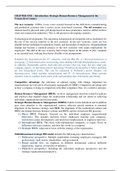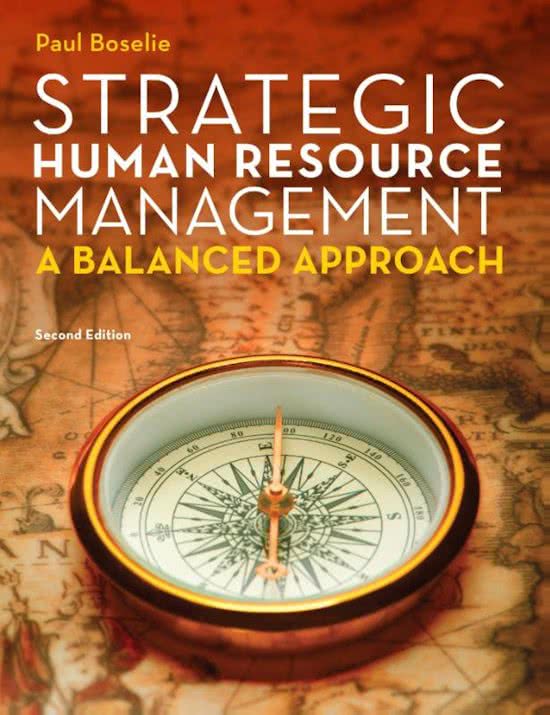CHAPTER ONE – Introduction: Strategic Human Resource Management in the
Twenty-first Century
The new economy. (1990s) it was a new concept focused on the shift from a manufacturing
and production economy into a service sector asset-based economy. The old economy was
characterised by physical tasks, job design based on mass production, and low-skilled workers
(steel and construction industries). This is still present in developing countries.
Technological developments. The upcoming technological developments led as facilitators for
the rise of the services industry in the new economy. In the new economy, assets are less
tangible and are embedded in reputation, brands, and knowledge of employees. Organizational
change has become a common practice in the new economy with major implications for
employees. The shift to the new economy had a major impact on the nature of jobs; computer
as an essential tool, working from home, flexible work arrangements.
Schnabel has characterized the 21st centuries, with the five I’s. (1) Internationalization is
increasing. (2) Individualization is increasing, more dealing with individual preferences, needs,
or affinities. Sustainable careers: both take into account what you want, but also what your
company expects. (3) Informalization is increasing. Nowadays the hierarchy is flatter, and there
are less hierarchical levels. This can be connected to Hofstede’s power distance. (4)
Informatization, which includes technolization and IT. (5) Intensification. More network
oriented, want to combine reach career goals and spending time with family and friends.
Competitive advantage: the relevance of optimal coping with change (important for
organizational survival and is at least partly manageable by HRM). Competitive advantage tells
us how a company is doing in comparison with other companies; thus, it is a relative outcome.
Human Resource Management (HRM): involves management decisions related to policies
and practices that together shape the employment relationship and are aimed at achieving
individual, organisational and societal goals.
Strategic Human Resource Management (SHRM): builds on this definition and in addition
pays extra attention to the organizational context, reflected special attention to potential
alignment of the business strategy and HRM, the alignment of the institutional context and
HRM, the linkage between business systems and HRM, and the fit between HR practises.
(1) Micro HRM. Primarily focussed on the individual employee (organisational
behaviour). This includes instroom ((new) employees entering your company),
doorstroom (career development), and uitstroom (outplacement, or employee turnover).
(2) International HRM. This deals with multinational companies, or expats. Focus on
differences between countries, and how this works in a company.
(3) Strategic HRM. Align micro focus with the strategy of the organization.
Multidimensional strategic HR model includes the following key characteristics:
(1) Multi-actor perspective. Multiple stakeholders including employees, managers, HR
professionals, trade unions, shareholders, and government.
(2) Broad societal view. An emphasis on different institutional contexts (different
departments, regions, or branches of industry).
(3) Multi-level perspective. Including the individual employee perspective and the
strategic organizational perspective.
,The above approach is reflected on by Paauwe. He argues the following. Human resources are
something more than just ‘resources’; Human resource management is not concerned solely
with financial performance; Human resource management focuses on the exchange relationship
between employee and organization; And the shaping of the employment relationship takes
place in and are of continuous tension between the added value and moral value.
The employment relationship is the focus of HRM and can be characterized by four contract
elements, which are; (1) legal contract, determines the rights and obligations of the
organization and employee, e.g. vacation days, confidentiality. (2) economic and transactional
contract, the employee and employer determine how much effort the employee puts into the
job reflected in the number of working days, and how much the employer will pay for the
employee’s efforts. (3) psychological contract, concerns all things that are not written down
but are expected from both actors. (4) sociological contract, incorporates social aspects related
to the relationships and networks employees have within an organization.
HRM operates in an area of continuous tension between added value (‘hard’ HRM) and moral
values (‘soft’ HRM). Boxall and Purcell comment on SHRM characteristics and argue the
following. HRM covers all workforce groups, including core employees, peripheral employees
and contingent workers; HRM involves line and specialist managers, and is not solely aimed at
employees; HRM is all about managing work and people, collectively and individually; HRM
is embedded in industries and societies.
➔ Both Boxall and Purcell as well as Paauwe argue that HRM should pay attention to the total
workforce instead of becoming the exclusive terrain for talent management and leadership
development.
Anglo-Saxon/ Anglo-American models: focus on creating shareholder value in terms of
profits and market value with little or no attention to other stakeholders.
Rhineland Models: acknowledge multiple stakeholders and their interests explicitly
considering employee interests in terms of well-being and societal interests.
Strategic balance model: organizational success can only be achieved when financial and
societal performance of an organization are above average in the organization. (balanced
approach). Not only looking at HRM on a short term, but also on the longer term.
Four perspectives/ frames (Bolman and Deal) for studying organizations. Frames: mental
models, maps, mind-sets, schemes, and cognitive lenses that people apply (un)continuously (1)
Structural frame. To gain understanding about the structural part of an organization, such as
rules, roles, goals, policies, or technology. (2) HR frame focuses on the employment
relationship, e.g. needs, skills and relationships. (3) Political frame examines issues of power,
e.g. power, conflict, or competition. (4) Symbolic frame builds on meaning and identity, e.g.
culture, meaning, ritual, stories, and heroes.
➔ There is largely focused on the structural frame in mainstream HR, while the political and
symbolic frame are often neglected.
, CHAPTER TWO – Strategic Human Resource Management and Context
Ongoing debate: about the relevance and necessity of fit (link or alignment) between HRM and
other aspects of an organization (to fit or not to fit). For this ‘enactment’ is needed.
Best-fit proposition: the ‘best-fit’ school argues that HRM is more effective when it is aligned
with its internal and external context. According to this proposition success can only be
achieved through the appropriate fit between HRM and its context (context: set of facts or
circumstances that surrounds the organization).
- The internal context represents the organization’s unique history, the
administrative heritage, and the culture.
- The external context reflects the outside mechanisms that affect the organization
or even interact with it.
Best-practice proposition: The ‘best-practice’ school advocates a universalistic perspective
(one size fits all HRM). Pfeffer’s identified seven HR practices for building profits by putting
people first. (1) Selective recruitment and selection. The focus lies on sophisticated recruiting
and selecting the best person for the job. (2) Extensive training. (3) Performance-related pay
(PRP). (4) Teamworking. As a way to break through the hierarchical model and decentralize
responsibility. (5) Information sharing and communication. (6) Reduction of status differences.
Such as elevators or parking spaces for executives. (7) Employment security. In terms of
employee benefits.
Business model: the way an organization manages its business to make money. Strategy: an
organization’s intention to achieve certain goals through planned alignment (or fit) between the
organization and its environment. These two concepts should both align with the HRM.
Goal-based strategy based on the organization’s vision (what) and mission (how). Strategic
formulation is the process of forging a cohesive integrated set of strategies designed to deal
with the environment and achieve the business strategic goals. Strategy implementation is the
actions the organization takes to execute the strategy it has formulated.
Environment of a business consists of the (1) general environment, which are social trends,
national culture, or political climate, as well as (2) business environment, which are customers,
suppliers, the economy, financial markets, or government regulations.
➔ Organizational field: A community of organisations that partakes of a common meaning
system and whose participants interact more frequently and fatefully with one another than
with actors outside the field. (Changes in one field can affect another field which is why it
could be important to take multiple fields into account)
Business strategy: the system of the firm’s important choices, a system that could be well
integrated around common concerns or which might have various links and foul-ups (cited from
Boxall and Purcell). The business strategy consists of different ‘functional silos’: competitive,
financial, operational, and HR strategy. HR strategy: one of the functional silos and the linkage
between the business strategy aimed at achieving the organizational goals through optimal
HRM. The configuration of all silos is important. The Harvard approach (figure below):
important to take into account stakeholders’ interests, situational factors, and long-term
consequences with designing HRM policy choices and HR outcomes.






